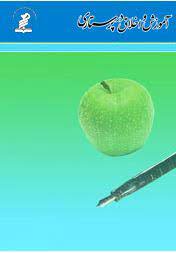تعیین وظایف بالینی ضروری دانشجویان پزشکی دانشگاه علوم پزشکی جهرم براساس پارادایم مدل داندی
نویسندگان
1 مربی، مرکز تحقیقات مولفه های اجتماعی نظام سلامت، دانشگاه علوم پزشکی جهرم، جهرم، ایران
2 متخصص طب اورژانس، مرکز تحقیقات بیماری های غیر واگیر،دانشگاه علوم پزشکی جهرم، جهرم، ایران
3 متخصص طب اورژانس، مرکز تحقیقات بیماری های غیر واگیر، دانشگاه علوم پزشکی جهرم، جهرم، ایران
4 استادیار، دانشکده مدیریت، گروه مدیریت آموزش عالی، واحد تهران شمال، دانشگاه آزاد سالمی، تهران، ایران
چکیده
مقدمه: با انجام ارزشیابی مناسب، می توان نقاط قوت و ضعف آموزش بالینی را شناسایی کرد و با تقویت نقاط مثبت و رفع نواقص، در جهت ایجاد تحول و اصلاح نظام آموزشی، گام برداشت. این پژوهش با هدف بررسی مدل سه دایرهای دانشگاه داندی، در تعیین وظایف ضروری دانشجویان بالینی دانشگاه علوم پزشکی جهرم، انجام گرفت.
روش کار: این تحقیق، مبتنی بر روش توصیفی – مقطعی است. افراد مورد بررسی، مشتمل بر کارورزان دانشگاه علوم پزشکی جهرم (اینترن) بودند، که در بخشهای داخلی – جراحی – اطفال – زنان و اتفاقات به فعالیت می پرداختند. نمونه گیری، به روش آسان و قابل دسترس (از بخش های مختلف به تفکیک سن و جنس) انجام گرفت. جمع آوری داده ها، با استفاده از پرسشنامۀ محقق ساخته انجام گردید. پرسشنامه، میان 50 نفر از کارورزان، در دانشکدۀ علوم پزشکی جهرم در بیمارستانهای پیمانیه و مطهری، که در بخشهای مختلف حضور داشتند توزیع گشت. برای تجزیه و تحلیل اطلاعات، از نرم افزار spss نسخۀ 21 و همچنین آزمون های آماری توصیفی ( میانگین، درصد و انحراف معیار ) و آزمونهای استنباطی ( رگرسیون و اسپیرمن ) استفاده شد.
یافتهها: بیشترین میزان رضایت، از کیفیت تجربه های بالینی به دست آمده در کارآموزی بالینی، در بخش جراحی(63.2 %) و کم ترین، در بخش پزشکی خانواده (63.2 %)، بوده است. بیشترین نمرۀ رضایت دانشجویان، در بخش پزشکی اجتماعی، داخلی، روانپزشکی و جراحی از مشاهدۀ حداقل یک استاد در هنگام معاینۀ فیزیکی و بیشترین نمرۀ رضایت دانشجویان در بخش کودکان، از فرصت مناسبی جهت پیگیری سیر درمان بیماران بوده است. بیشتر دانشجویان، یادگیری های آموزشی را در زمینۀ مهارتهای مصاحبه با بیمار(65.8 %)، مراقبت از بیماران بستری(65.8 %) و مهارت برقراری ارتباط پزشک و بیمار(65.8 %)، کافی(مناسب و خوب) دانستهاند. همچنین بیشتر این دانشجویان، در قسمت یادگیری های آموزشی، مهارت برقراری ارتباط پزشک و بیمار را، با بهرهگیری از مترجم در صورت نیاز(63.2 %) و مراقبت از بیماران سالمند(65.8 %)، ناکافی دانستهاند. آنگونه که باز بیشتر این دانشجویان، یادگیری های آموزشی را در محدودۀ ثبت دادههای پزشکی(65.8 %) و رازداری و حفظ حریم بیمار(81.6 %)، کافی(مناسب و خوب) دانستهاند. همچنین بیشتر دانشجویان، یادگیری های آموزشی را در حیطۀ اقتصاد پزشکی(35.1 %) و پزشکی مبتنی بر جمعیت(31.6 %)، را ناکافی دانستهاند.
نتیجهگیری: پژوهش حاضر نشان داد، که استفاده از مدل سه دایره ای دانشگاه داندی، روشی مؤثر در شناسایی نقاط قوت و ضعف دانشجویان پزشکی، در ارتباط با آموزش های بالینی میباشد.
کلیدواژهها
عنوان مقاله [English]
Determining the essential clinical duties of medical students of Jahrom University of Medical Sciences based on the Dundee model paradigm
نویسندگان [English]
- Navid Kalani 1
- Samaneh Abiri 2
- Mehdi Chegin 3
- Mojtaba Moazzami 4
1 Instructor, Research Center of Social Components of Health System, Jahrom University of Medical Sciences, Jahrom, Iran
2 Emergency Medicine Specialist, Non-Communicable Diseases Research Center, Jahrom University of Medical Sciences, Jahrom, Iran
3 Emergency Medicine Specialist, Non-Communicable Diseases Research Center, Jahrom University of Medical Sciences, Jahrom, Iran
4 Assistant Professor, Department of Educational Management, North Tehran Branch, Islamic Azad University, Tehran, Iran
چکیده [English]
Introduction: By conducting a proper evaluation, it is possible to identify the strengths and weaknesses of clinical
education, and by strengthening the positive points and eliminating the shortcomings, steps can be taken in the direction of reforming the educational system. This study was conducted with the aim of investigating the three-circle model of Dundee University in determining the essential duties of clinical students of Jahrom University of Medical Sciences.
Materials and Methods: This research was carried out using a cross-sectional descriptive method. The subjects of studied were interns of Jahrom University of Medical Sciences (Intern) who were working in internal, surgery, pediatrics, women and events departments. Sampling was done in an easy and accessible way (from different sections by age and sex). Data collection was done using a researcher-made questionnaire. The questionnaire was distributed among 50 interns in Jahrom Faculty of Medical Sciences in Peymaniyeh and Motahari hospitals who were present in different departments. Data analysis was done using spss software version 21 as well as descriptive statistical tests (mean, percentage and standard deviation) and inferential tests (regression and Spearman).
Results: The highest level of satisfaction with the quality of clinical experiences gained in clinical internship was in the surgery department (63.2%) and the lowest in the family medicine department (63.2%). The highest satisfaction score of students in social medicine, internal medicine, psychiatry and surgery department was from observing at least one professor during physical examination, and the highest satisfaction score of students in pediatric department was a good opportunity to follow the progress of patients' treatment. The majority of the students considered the training in patient interviewing skills (65.8%), taking care of hospitalized patients (65.8%) and doctor-patient communication skills (65.8%)
as sufficient (suitable and good). Also, the majority of the students considered the educational training in the field of doctor-patient communication skills using an interpreter if needed (63.2%) and caring for elderly patients (65.8%) insufficient. The majority of the students found the educational training in the field of medical data recording (65.8%) and confidentiality and privacy of the patient (81.6%) to be sufficient (suitable and good). Also, the majority of students considered education in the field of medical economics (35.1%) and population-based medicine (31.6%) to be insufficient.
Conclusion: Based on the results of the present study, it was determined that using the three-circle model of Dundee
University is an effective method in identifying the strengths and weaknesses of medical students in relation to clinical training.
کلیدواژهها [English]
- Dundee Model
- Intern
- Medical Students
- Clinic
- Clinical Duties
- Zamanzadeh V, Abdollahzadeh F, Lotfi M, Aghazadeh A. [Evaluation of clinical education areas from the perspective of nursing and midwifery instructors of Tabriz University of Medical Sciences in 2006]. Iranian Journal of Medical Education 2007; 7 (2): 299- 307.
- Shahbazi L, Salimi T. Status of clinical education of opinion of yazd university medical student. Yazd University of Medical Sciences. 2000; 8(2): 97-103.
3. Rahimi A, Ahmad F. The obstacles and improving strategies of clinical education from the viewpoints of clinical instructors in Tehran's Nursing Schools. Iranian J Med Educ 2005; 5(2). - N Yamani. T Changiz. Proposing a participatory model of evaluation. Iranian Journal of medical science 2006; 6(2):115-22
5.L Chen, Y Li. Ability learning› students the improve to study .Research and Teaching Language of Journal /17507.10/org.
6.Habibi H, Khaghanizade M, Mahmoodi H, Ebadi A, seyedmazhari M.[Comparison of the Effects of Modern Assessment Methods (DOPS and Mini- CEX) with traditional method on Nursing Students' Clinical Skills: A Randomized Trial]. Iranian Journal of Medical Education 2013; 13(5):364-372.
- Smith- Strom H, Nortvedt MW. Evaluation of evidence- based methods used to teach nursing students to critically appraise evidence. J Nurs Educ 2008; 47(8):372-5.
8-Harden R, Creoy J, Davis M.AMEE guide no.14:outcome based education:part1-introduction to outcome based. Med Teach 1999; 21(1):7-14.
- Moosavi M, Koohpayehzadeh J, Soltani Arabshahi S K, Bigdeli S, Hatami K. Assessment of educational environment at main clinical wards in teaching hospitals affiliated to Iran University of Medical Sciences: stagers and Interns viewpoints based on modified DREEM. RJMS 2015; 21(129):58-67
URL: http://rjms.iums.ac.ir/article-1-3607-fa.html - Abdollahi S, Bakhshi H, Ebrahimi Shahmabadi H, Soltani Nejad A. The Medical Students' Viewpoints in Achieving Clinical Objectives of Medical Education Program in Rafsanjan University of Medical Sciences in 2010: A Short Report. JRUMS 2017; 15(11):1077-1086.
11.Ginzburg SB, Brenner J, Cassara M, Kwiatkowski T, Willey JM. Contextualizing the relevance of basic sciences: small-group simula- tion with debrief for first- and second-year medical students in an integrated curriculum. Adv Med Educ Pract 2017; 8:79–84.
- Teshome D, Tiruneh C, Berhanu L, Berihun G. Medical students’ attitude and perception towards basic medical science subjects at Wollo University, Northeast Ethiopia. Advances in medical education and practice 2021; 12:431.
13.Gupta S, Gupta AK, Verma M, Kaur H, Kaur A, Singh K. Students’ perceptions of basic science subjects. Int J Appl Basic Med Res 2014:4.
14.Khoshrang H, Salari A, Dadgaran I, Moaddab F, Rouh-Balasii L, Pourkazemi I. Quality of Education Provided at The Clinical Skills Lab From Medical Students’ viewpoints in Guilan University of Medical Sciences. RME 2016; 8(2):77-83.
15.Zamanzad B, Moezzi M, Shirzad H. [Rate of satisfaction and evaluation of medical students (interns and externs) from the quality of clinical education in the Shahre-kord university of medical sciences]. Journal of Semnan University of Medical Sciences 2007; 9(1):13-21.
16.Arabi M, Abolfazli M, Riahi S, Nosrati S, Tajbakhsh R. The Educational Environment of Main Clinical Wards in Educational Hospitals of the Alborz University of Medical Sciences. aumj 2021; 10(3):277-284.
17.Sayyadi M, Vahabi A, Roshani D, Vahabi B. Nursing student’s perspective regarding the clinical learning environment and the factors affecting it in 2015. Scientific Journal of Nursing, Midwifery and Paramedical Faculty 2016; 2(2):33-44.
- Sanagoo A, Faghani M, Joybari l, Mansorian A. Views of learners on learning environment based on the model DREEM in Golestan Universit. Journal of Medical Education Development 2013; 6(12):43-50.
- Heydari M, Shahbazi S, Ali-Sheykhi R, Heydari K. Nursing student viewpoints about Problems of Clinical education. Journal of Health and Care 2011; 13(1):0-.
20.Hadizadeh F, Firoozi M, Shamaeyan Razavi N. Nursing and midwifery students’ perspective on clinical education in Gonabad University of Medical Sciences. Iranian J Med Educ 2005; 5(1):70-8.
- Forbes H. Clinical teachers’ approaches to nursing. J Clin Nurs 2010; 19(5-6):785-93.
22.M I Amini, F R Takmil, S A Abiri, M R Dehghani, J A Kojuri. The use of the Dundee three-circle model to assess quality of medical education. Medical Teacher 2014; 36(9): 825-6.
 آموزش و اخلاق در پرستاری
آموزش و اخلاق در پرستاری
